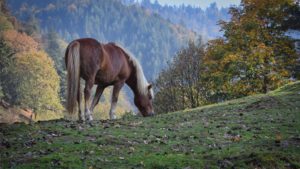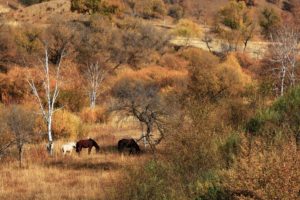 As summer starts to fade and the beauty of fall emerges now is a good time to carry out some fall health and management checks to help prepare for the winter months.
As summer starts to fade and the beauty of fall emerges now is a good time to carry out some fall health and management checks to help prepare for the winter months.
VACCINATIONS: fall vaccinations will depend largely on location and horse’s risk level, so discuss options with your veterinarian to ensure your horse is properly covered.
PARASITE CONTROL: as grasses get shorter in fall, parasite loads tend to increase as horses graze closer to manure and this places even more importance on parasite control including deworming. Fecal egg counts are suggested to provide a program that works for your situation and geographical area as well as reducing the risk of drug resistant parasites.
DENTAL CHECKS: a yearly dental check is recommended for all horses and fall is a great time to do this, to ensure that going into winter your horse can chew correctly and thus make the most of his diet in order to sustain body condition over winter. Older horses and those with teeth issues may need more regular check ups
EVALUATE YOUR HORSES CONDITION: Asses your horses body condition so you can make changes before winter arrives. For horses that are underweight additional calories will need to be added for weight gain, this can be done in the form of higher calorie concentrates, higher calorie grasses such as Alfalfa, added fats and oils, or super fibers, such a beetpulp products which provide calories without excessive amounts of starch or sugar. Speak to a nutritionist to ensure the right option is selected for your horse.
For those that are overweight fall and winter can be a good time to help your horse drop. However, consider using a balancer to ensure all the daily essentials are provided without the calories, as even good hay and grazing can be deficient in nutrients.
PASTURE CONDITIONS: This can be largely dependent on your area, as for some, fall signifies the dwindling of grass growth while for others an increase in rainfall produces a flush of new grass before winter sets in.
In areas where grass is sparse consider introducing more hay to your horses in both their stall and paddock. When grazing is not as available horses tend to indulge in vegetation which may not be suitable and could lead to poisonings thus providing extra hay can help avoid this. Additional hay also helps to support the drop in nutritional value of pasture during winter months.
Pasture has a much higher water content than hay and so by adding more hay, water intake is reduced. Giving the horse time to change over slowly to a higher forage-based diet will give them time to alter their drinking habits in order to consume more and help reduce the risk of impaction colic. Including 1 tablespoon of salt per 500lbs of body weight is a good guide to stick to as including sodium helps to stimulate thirst and ensures your horse consumes enough water.
Research has shown that tepid water is drunk in much higher volumes and so when temperatures drop ensure your horses water is at a more tepid temperature to ensure they drink enough.
Calculate and ensure you have adequate supplies of hay as stocking up will not only help you avoid the higher winter prices but ensure you have enough to last you through the winter months. Horses should receive at least 1.5% of body weight per day in additional roughage. However, you may end up needing more to sustain your horses body weight in winter and so estimating on 2% of body weight per day per horse would give you a more accurate reflection of how much you need to buy. Due to drought and fires in many areas hay supply this year could run low and so if you feel this may be a concern think about adding additional roughage support to the diet by using chopped hay, hay cubes/pellets and or beet products. Ensure your storage area is pest free and protected from the elements to guarantee your hays longevity.
BEWARE OF LAMINITIS: For those living in areas where rains return in fall causing a flush of grass growth be aware that this grass flush can be as risky as spring grass for horses at risk from laminitis. Pasture grasses contain high levels of soluble sugars and NSCs during their active growth phase. When cold temperatures cause growth to cease, the sugar cannot be utilized as fast as it is produced and thus it accumulates in the plant in an attempt to fuel regrowth. For horses prone to laminitis, restrict or avoid grazing when night temperatures are below 40F, followed by sunny days as the colder nights will prevent the plant from using its sugars leading to higher levels of NSC in the day.
For all horses there is a seasonal increase of the hormone ACTH from mid-August through November. This rise is related to changes in hormone activity ultimately responsible for winter coat growth. However, in horses with Cushings (or undetected Cushings) this seasonal ACTH rise generates levels much higher than normal. This is a concern as ACTH stimulates the adrenal gland to produce cortisol and long-term elevated cortisol puts vulnerable horses at high risk for fall laminitis and/or insulin resistance. Its therefore advisable to test your older horse for Cushings during this time in order to avoid long term issues.
MATCH DIET TO EXERCISE: Ensure that your horses diet matches this workload. Horses may experience a drop in exercise in fall and winter and so the diet would need to be matched to ensure excessive weight gain and/or behavioural changes are not seen. For those still in work and performing regularly make sure your diet accounts for the drop in nutritional value of pasture and that additional supplementation is provided if necessary.
DO SOME HOUSEKEEPING: Address anything that needs fixing. Repairs ignored now will become much bigger problems once winter is in full swing. In cold areas ensure your pipes are insulted enough to avoid freezing and even have your barn checked for structural integrity to ensure it can withstand heavy snow falls. Assess areas of your pasture and yard that are known to become muddy and either ensure that the water run-off is adequate or place a covering (such as wood chips or a commercial pad or panel) to help manage mud in these areas. Check light fittings work and that you have enough for those darker days. Now is also the time to check blankets and ensure they fit correctly, are clean and ready to use.
If you have any concerns about your horse’s diet or condition this autumn do not hesitate to reach out. We are here to help!